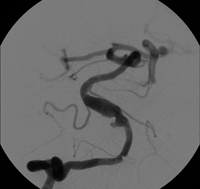Basics of cerebral angiography and neurointerventional surgery
 Cerebral angiography is a minimally invasive procedure where x-ray contrast dye is
injected into the blood vessels of the brain and images are obtained. This medical
imaging technique is the gold standard for detecting problems in the blood vessels
of the head, neck, and spine.
Cerebral angiography is a minimally invasive procedure where x-ray contrast dye is
injected into the blood vessels of the brain and images are obtained. This medical
imaging technique is the gold standard for detecting problems in the blood vessels
of the head, neck, and spine.
Diagnostic images taken with cerebral and spinal angiography are most frequently used to identify aneurysms, vascular malformations, narrowing of blood vessels and vasculopathy. Angiography can be used whenever more specific diagnostic information regarding the blood vessels of the head, neck, and spine is needed than can be provided by non-invasive imaging, such as computed tomography (CT), magnetic resonance imaging (MRI), etc.
Cerebral angiography is performed by neurointerventional surgeons. In addition to diagnostic imaging, neurointerventional surgeons can treat head, neck and spinal conditions from within the patient's blood vessels. For example, neurointerventional surgeons can place platinum coils in an aneurysm sac to help heal the lesion. They can treat acute strokes by using mechanical retrieval devices or even by infusing intra-arterial medications at the site of the clot. There are many other conditions that they can treat, including: arteriovenous malformations or fistulas of the brain or spine, severe intractable nosebleeds, narrow blood vessels in the head or neck, etc. Neurointerventional devices and techniques are rapidly evolving, and neuirointerventional surgeons are now able to treat many conditions that used to require open brain surgery or were previously untreatable.
Neurointerventional surgeons work closely with neurologists and neurosurgeons to determine the best treatment plans for patients. Treatment typically includes medical management, neurointerventional surgery, vascular neurosurgery or a combination thereof. Patients may subsequently be monitored with periodic angiograms and/or by non-invasive studies.
Additional information: Safety of Cerebral Angiograms, Treating Aneurysms, Angioplasty & Stents, Stroke Treatments, Vertebroplasty, and Stenosis
Why should the neurosurgery team treating you include a neurointerventional surgeon?
A neurosurgery team that includes a neurointerventional surgeon has better diagnostic capabilities and more surgerical options. Cerebral angiograms are the gold standard of diagnostic imaging, and studies like ISAT provide evidence to suggest that patients treated with neurointerventional techniques tend to have better outcomes. If you are getting elective brain surgery, it is worthwhile to make sure your case has been reviewed by a neurointerventional surgeon, preferably one with significant experience treating your condition.